
- MILL HILL
WILDLIFE REPORTS 2015

 |
 |
 |
 |
|
|
|
|
|
Noticeable
summer plants of the upper meadows include Greater
Knapweed, Hardheads (=Lesser Knapweed),
Field
Scabious, Meadow Cranesbill, Alexanders,
Pyramidal
Orchids, Plantains,
Melilots,
Meadow Vetchling, Yarrow,
Eyebrights,
Musk
Thistles, Hounds-tongue*,
Perforate
St. John's Wort*, Great Mullein* and
many others. Herb Robert is
found amongst the scrub.
(*notably
on disturbed ground.)
Some
Indicator Plants of Ancient Downland
 |
 |
 |
 |
|
|
|
|
|
Other
indicators on the lower slopes include Dropwort,
Autumn
Ladies Tresses (upper plateau), Hairy
Violet,
all
of which are rarely found on pastures, restored wildlife meadows or agricultural
downland. Other downland plants that are more likely on the biodiverse
down herbland are Wild Thyme,
Carline
Thistle, Stemless Thistle, Squinancywort,
Fairy
Flax, Small Scabious,
Common
Centaury and
Wild
Basil. There are other more widespread
wild plants like the Mouse-eared Hawkweed,
Hawkbits, Autumnal Hawkbit, Bird's Foot Trefoil, Ground
Ivy, Germander
Speedwell, Field Speedwell, Sweet Violet,
Self-heal
and Yellow Wort.
Wild
Flora and Fauna on Chalk flickr
Adur
Wild Flowers 2009
| OVERVIEW:
A large part (724 acres) of the downs including Mill Hill were presented to the people of Shoreham in 1937. Just over 30 acres still remain as public open land and a Local Nature Reserve. This is divided into about 11 acres of grassland and meadows above the ridge, about 9 acres of scrub, the copse and glades at the northern end, and about half of the prime Chalkhill Blue area of 6.4 acres of herbland remaining. 6 acres has been lost to a Sycamore woodland on the southern slopes. This is low fertility chalkland not suitable for grazing. The top area is effectively a wild meadow and the lower slopes a rabbit warren dominated by prostrate (not the upright form) Horseshoe Vetch, Hippocrepis comosa. |

Horseshoe Vetch |
||||||
| Chalkhill Blues:
Mill
Hill is nationally important because of its population of Chalkhill
Blue Butterflies. Estimates of the numbers
are notoriously inaccurate. In the 1950s
the population was estimated by R. M. Craske
to
be 50,000. This may be an exceptionally good year. I would estimate the
numbers at that time to be nearer 25,000 for Mill Hill only. After the
cattle grazing and thorn incursions the numbers plummeted to the most reliable
estimate in 1960
of 6,000. The new road and Sycamore woodland further denuded the Horseshoe
Vetch, Hippocrepis comosa,
and bare chalk downland to a figure I have estimated at a top figure of
3,000 Chalkhill Blue Butterflies at the turn of the millennium (counted
in 2003). Almost
all these butterflies are now to be found on the six acres of the lower
slopes.
|
 |
||||||
| "Our
family lived at The Mill House, Mill Hill, from around 1933
until about 1967, and every July we saw the
"Butterfly Men" walking past onto the Downs. My father used to tell
us that they were interested in the blue butterflies."
Heather
Clark (née Eager), Ryde, Isle of Wight
|
Nearest
Postcode: BN43 5FH
Grid Ref: TQ 21170 07444 (upper car park) Geographic Link OS Map Google Earth Map Magic Map of Mill Hill NR Local Nature Reserve Designation Natural England: Local Nature Reserves Multi-Map (Bird's Eye View) Grid Reference Finder |
FEATURE:
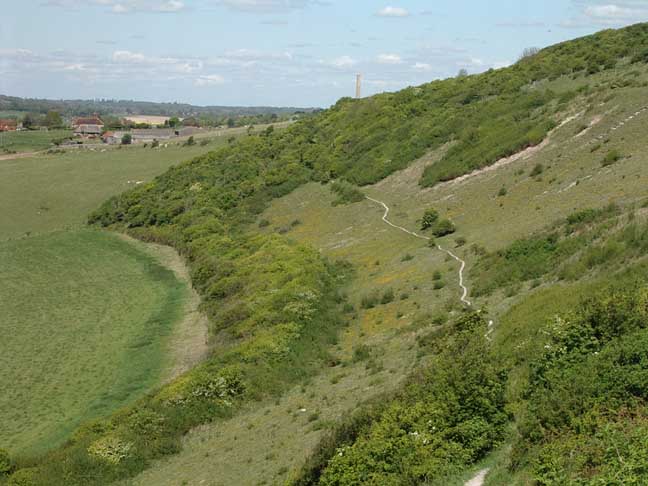
 |
The butterfly lower slopes at Mill Hill are under serious threat by a natural process known as ecological succession where the woody shrubs like Privet, Brambles and Hawthorn invade the herb-rich slopes gradually turning the downs into woodland and eliminating the butterfly larval food plants especially the Horseshoe Vetch, Hippocrepis comosa, on which the Chalkhill Blue Butterflies rely. The remedy is by expert professional removal of the Privet on a regular basis. This job is now being undertaken by volunteers. |

 |

flickr |

|
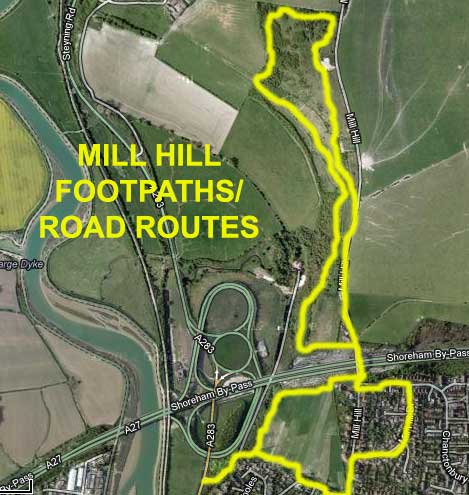 |
OS
Map
Footpaths at Mill Hill WILDLIFE REPORTS |
28
October 2015
I
took my two dogs for a walk to Mill Hill
as the weather was too good to miss. I began to think that even with the
temperature close to 18 ºC, after more than an hour I had not seen
any butterflies only this day flying Silver
Y Moth.
I
was about leave and 3 Clouded Yellows
appeared (1 female and 2 males) and a Wall
Brown.
20
October 2015
Nothing
much moved, no butterflies although I did
spot an Autumn Gentian
in flower on the lower slopes with a
few Yellow Wort,
some budding Carline Thistle,
one Sweet Violet,
one Devil's Bit Scabious, a
few diminutive Milkworts
and Self-heal,
and occasional Ragworts, Hawkbits and
Dandelions.
As I was leaving a Kestrel swooped down on some prey, but left the lower slopes after a pause without anything visible in it talons.
13
October 2015
Scores
of House Martins
flew to and fro over the steep slopes of Mill Hill, their plump white bellies
catching the light of the intermittent midday sunshine. There were over
fifty but less than a hundred House Martins
and only two Swallows
that flew over but did not join in the melee. They were not continually
in flight and some birds chose the largest Elderberry
bush (no berries) on the steep slopes as an
occasional perch. Other House Martins
preferred to land on the ground. In the straggly hedgerow at the bottom
of Mill Hill, the commotion was halted by the whirring flight of a male
Pheasant
flushed from cover.
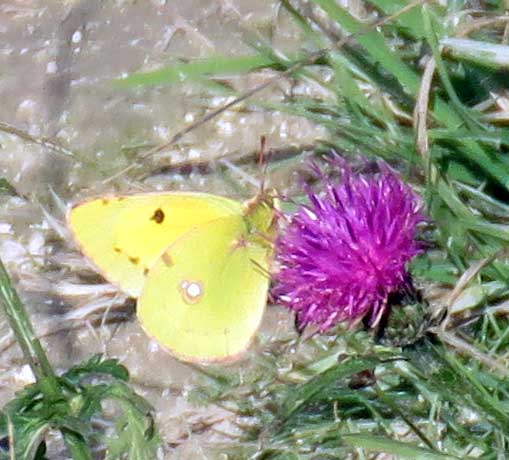 |
 |
 |
|
|
|
|
A Clouded Yellow Butterfly was seen immediately I descended the southern steps to the lower slopes. It settled immediately on a Hardhead flower by the path, but I could not close enough for a decent photograph as the sun was casting lengthy shadows. There were three sightings of this fast flying butterfly on different parts of the lower slopes but it was flying so strongly it could have been the same one. Just one Meadow Brown was spotted and a Large White seen up closely. Flowers were exiguous but included at least two, possibly three species of yellow hawkbit/weed type plants, thought to be Rough Hawkbit and possibly Autumnal Hawkbit. I noted thousands of violet leaves and I thought there was far more than usual and a few Dog Violets were seen in flower on the steep and lower slopes. I spotted the Easter Fox Spider Alopecosa barbipes on the lower slopes of Mill Hill. It was chanced upon crawling over the short vegetation amongst the violets. Still no Autumn Ladies Tresses on the upper plateau and I did not note any Autumn Gentian or Harebells, and just a single Yellow Wort still in flower. No Musk Thistle was spotted anywhere and no Dodder spotted at all this year.
11
October 2015
In
the fading light on a late still sunny shirt-sleeves late afternoon (after
four), I visited the lower slopes of Mill Hill where I spied five good
condition Meadow
Browns and at least five strong-flying
Clouded
Yellows. There was also a Small
White and a few Red
Admirals over the top of the hill.
Adur
Butterfly Report
4 October
2015
A
short walk round the top of Mill Hill
produced three Wall Browns,
three Meadow
Browns and two Small
Heaths.
There
were still a wide variety of flowers
but overall they were not very numerous. Of special note there were frequent
Dog
Violets on the lower slopes, at least
one budding Autumn Gentian
(in the last few years there have been hundreds on the upper plateau where
I did note any on passage) and an occasional Dwarf
Thistle and the inevitable and common
Carline
Thistles with mostly silver of gold ageing
leaves.
Butterfly
Report
23
September 2015
Cloudy
but at least it was not raining and anything
fluttering in the breeze was more likely to be a fallen leaf as
the equinox passes and the days become even shorter. A
Kestrel
hovered over the upper part of the hill making a few unsuccessful dives
whilst I was watching.
On
the lower slopes of Mill Hill it was so
cool it was not enough just to disturb the occasional remaining butterflies,
in most cases they had to be spotted resting. This was certainly true of
the five Small Heath Butterflies. One
resting female of the blues on Carline
Thistle, was not identified (it could
be either the female Chalkhill, Adonis
or Common Blue?).
The seven Meadow
Browns
and
a Red Admiral
were more flighty but looked to hide after being disturbed.
Devil's
Bit Scabious proved attractive to a Small
Heath Butterfly and a small bee,
possibly Halicitus or
Lasioglossum. Small cliff edges of
exposed soil were used by congregations of the
Ivy Bee, Colletes
hederae. Some Ploughman's
Spikenard were still in flower.
Carline
Thistle was in various stages from the
old grey remains from the previous year, to this year's plants with green,
silver and gold leaves to at least one freshly budding growth. They were
attractive to bumblebees
(mostly Carder Bees)
but not butterflies.
I
looked for Autumn Gentian
and only found one budding flower on
the top plateau and I could not find any Musk
Thistle or Dodder
or Autumn Lady's Tresses anywhere.
8
September 2015
On
a grey cloudy day, I thought there would be
so few butterflies,
I would be able to count them. Almost all were resting I and I had to almost
tread on them to spot them in the afternoon.
 |
 |
 |
|
(Worn specimen, ID not definite) |
|
|
The lower slopes of Mill Hill with its short vegetation still did not make the resting butterflies easy to find although there was a flash of blue immediately after descending the southern steps. The bright blue of 32 (26+6) of the Adonis Blues were the easiest to spot especially if they chased after the six brown females. 39 Meadow Browns were the most numerous, much larger than ten Small Heaths. All these were in the transect acre with a few (3+1) Common Blues appreciably smaller in size than the worn Adonis Blues. A Green-veined White was belatedly identified from a photograph and a Carpet Moth was noted on a Privet leaf. A Common Darter (dragonfly) landed on some straw (=dead grass). The pyralid micro-moth Pyrausta purpuralis was frequently seen on the lower slopes.
More
of the same resting butterflies on the middle slopes with one male Adonis
Blue, five Small
Heaths, at least seven Meadow
Browns
and
a Small White recorded.
One pyralid
micro-moth Pyrausta
purpuralis was seen on the middle
slopes and there was likely to be more. Frequent Sweet
Violets were flowering
on the lower slopes with one Round-headed
Rampion seen.
Adur
Butterfly Day List
 |
 |
 |
|
|
|
|
On
a cloudy day the butterflies
were very frequent, but not too many to count. Almost
all were resting. I stumbled across 50+ Meadow
Browns,
20+ Adonis Blues,
and a few Chalkhill Blues,
Common Blues and
Small
Heaths on Mill Hill.
Devil's
Bit Scabious was seen for the first time
this tear and a few Sweet Violets
were flowering on the lower slopes and
the first Autumn Gentian
was budding on the upper plateau. One of the Chalkhill
Blues on the slopes to the north of the Reservoir
was extremely worn and decrepit as shown in the photograph (above far right).
Adur
Butterfly Day List
Mill Hill
28 August 2015
Two Kestrels hovered over Mill Hill and one swopped to land on the steeper slopes. Grasshoppers hopped about in thousands especially in the longer grass on the southern part of Mill Hill.
After
a week of rain, a took my first opportunity
between the showers to visit the lower slopes of Mill Hill in the middle
of the afternoon. It was still too cool for the blue butterflies to be
active but the Carline Thistle
provided an attractant in addition to the butterflies
disturbed as I walked along the one acre transect.
Meadow
Browns
were
common and I estimate a number of 150+ actually seen and these are the
ones I dislodged in passing. They varied considerably in size. Thirty or
so Small Heaths
were slightly more active, but I did not manage a sighting of a Gatekeeper.
Male Adonis Blues
were spotted resting or visiting Carline Thistle.
28 males were counted on the transect acre, ahead of 20 male Chalkhill
Blues and ten Common
Blues
(5 males and 5 females). There were four large brown females which could
be either Chalkhill Blue
or Adonis Blue?
The only other butterfly species seen flying was a brief sight of a Clouded
Yellow.
I think I disturbed it as I passed with six Carpet
Moths, one Treble-bar
Moth and a few
Silver Y Moths. The
pyralid
micro-moth
Pyrausta purpuralis was frequently
seen on the lower slopes and one Pyrausta
nigrata. There was possible Holly
Blue Butterfly over the hedgerow north
of the bridge.
A
few Common Darters
(dragonfly)
were noted. A Sweet Violet
was seen in flower.
19
August 2015
 |
 |
 |
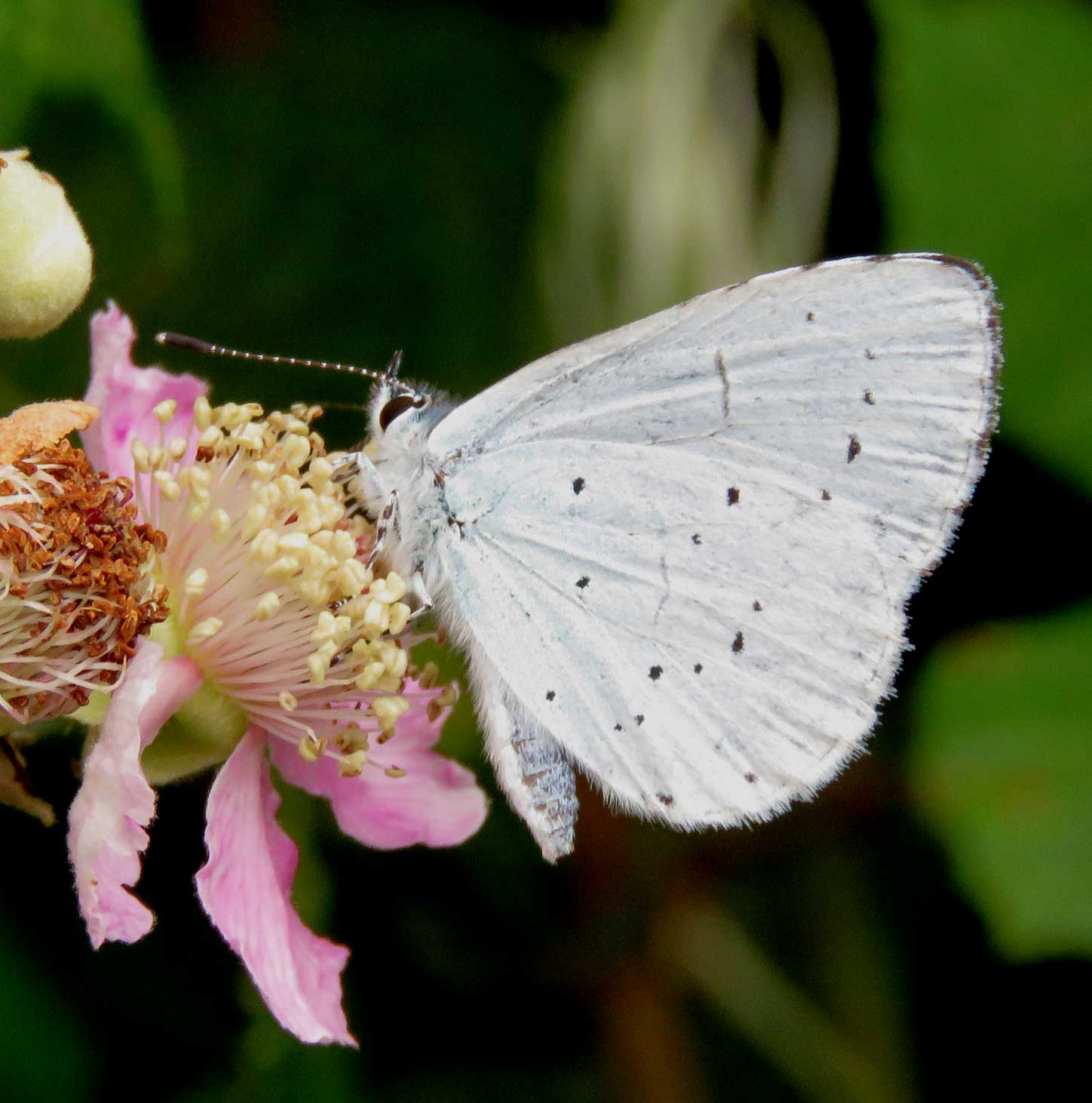 |
|
|
|
|
|
A visit
on a cloudy afternoon to the lower slopes of Mill Hill was unlikely to
be special but I did manage to chance upon a Holly
Blue at the top of Chanctonbury Drive
(south of the bridge). On the southern steps a Speckled
Wood basked in the low mist. Conditions
were dull enough to discourage butterflies
from active flight and all seen were either disturbed or spotted resting.
The radiant blue of the first of seven male Adonis
Blues caught my eye before the first of
a dozen male Chalkhill Blues.
There were two large brown butterflies which could be either a female Adonis
in good condition of almost certainly a female Chalkhill
Blue which was already worn. Meadow
Browns
20+
were frequently seen but Gatekeepers
were only occasionally spotted. In the transect
acre Wall
Browns numbered five in about 20 minutes
and one was worn and faded. One Peacock
Butterfly was seen in flight. And that
was the lot although it was worth mentioning that I had never seen so many
active pyralid moths.
Over fifty Pyrausta despicata
and 15+ Pyrausta purpuralis
were both seen on the lower slopes. Large moths
included a Treble-bar. By
the time I reached the middle slopes conditions were dull for any movement
and by the top of the hill it was raining. I hurried home spotting a handful
of Meadow
Browns
disturbed
in the long vegetation.
| At the time I thought this was probably the only Common Blue seen on the day on the lower slopes of Mill Hill. I am not absolutely sure from the photograph. It could be an Adonis Blue? |
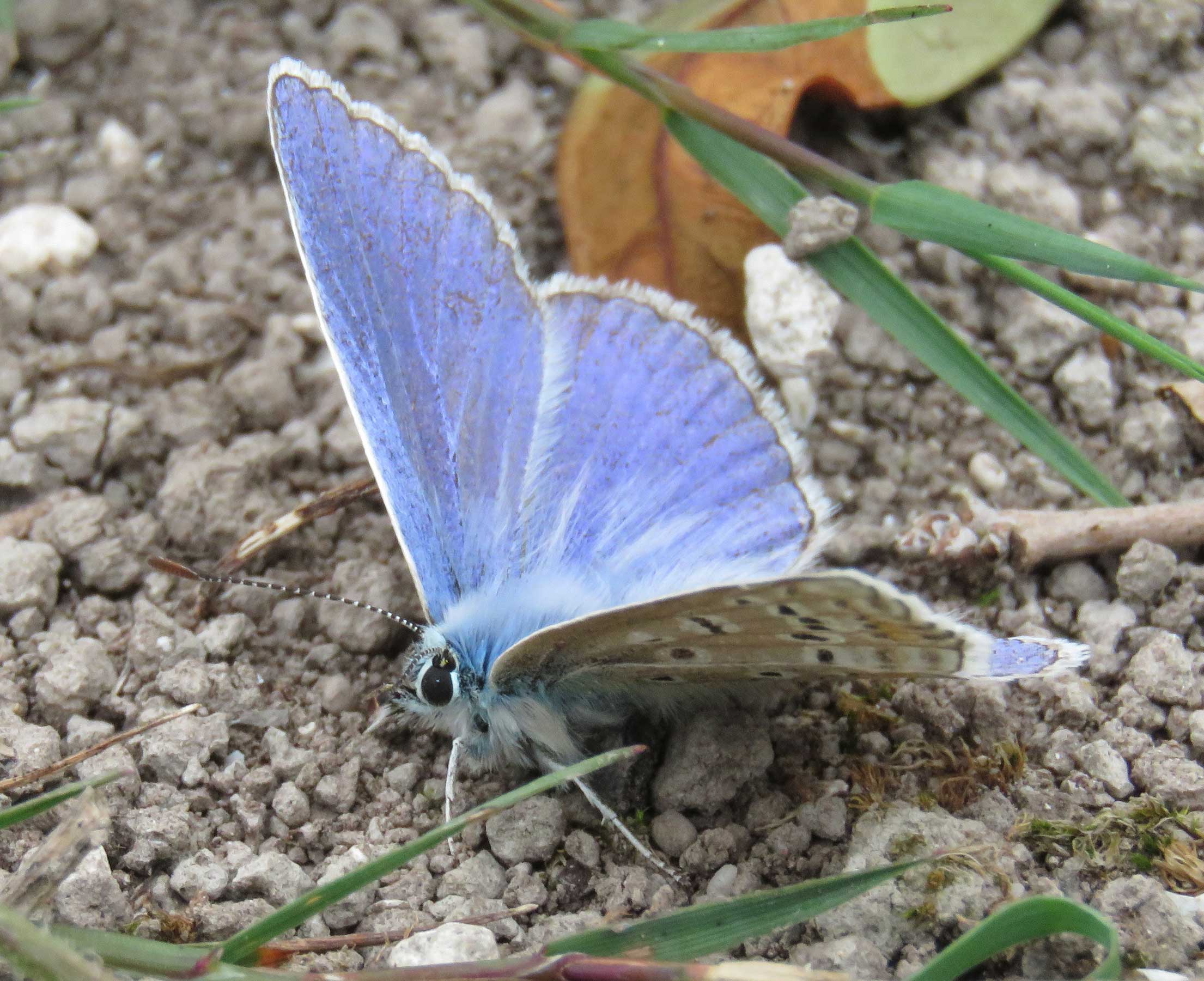 |
I did my Mill Hill transect while the weather was suitable. The Buddleia by the car park was covered in Painted Ladies, Small Tortoiseshells, Red Admirals and Peacocks - a reminder of childhood. Meadow Browns and Small Tortoiseshells were the winners this week: Adonis Blue 14, Brown Argus 2, Chalkhill Blue 20, Common Blue 11, Gatekeeper 7, Large White 1, Meadow Brown 70, Painted Lady 3, Peacock 3, Red Admiral 4, Small Heath 4, Small Tortoiseshell 7, Small White 1, Speckled Wood 2, Wall Brown 5. (Colin Knight Postcards from Sussex)
 |
 |
 |
|
|
|
|
I made a brief visit to the lower slopes of Mill Hill to see how the Chalkhill Blues were faring there, although it was getting a bit late in the afternoon on an overcast day. There was a Holly Blue around the hedge, north of the bridge. Numbers of Chalkhill Blues were again low with an estimated 75 males and two females spotted. Lo and behold, a fresh male Adonis Blue was unmistakable amongst a dozen or so Common Blues, frequent Meadow Browns and occasional Gatekeepers, Large Whites and at least one Wall Brown, and a definite Green-Veined White. (Other butterfly watchers had arrived earlier and seen more butterflies including Clouded Yellows, a Dark Green Fritillary and a Silver-spotted Skipper.) Macro moths included a Treble-bar and a Yellow Shell Moth. The pyralid micro-moths Pyrausta despicata and Pyrausta purpuralis were both seen on the lower slopes.
12
August 2015
I
did my Mill Hill transect on a warm but cloud covered morning, which accounted
for the low numbers of everything except Walls. It was wonderful to see
the brilliant colour of second brood Adonis
Blues. Later the sun shone through and
the butterflies rose up in numbers. Results: Adonis
Blue 3, Chalkhill Blue 13, Common Blue, Essex
Skipper, Gatekeeper 6, Meadow Brown 20, Peacock, Red Admiral, Small Heath,
Small White, Wall Brown 8.
Middle
Slopes of Mill Hill
Marjoram
and Hemp Agrimony
A cloudy
morning was not the optimum time to visit Mill Hill as the butterflies
had not awoken and I even managed to disturb three resting Clouded
Yellows (they are usually endlessly restless).
Two were on the lower slopes and one on the middle. But I was still unpleasantly
shocked how low the butterfly count in the
transect acre on the lower slopes actually
was. I recorded a mere 39 all male
Chalkhill
Blues, 36 Meadow
Browns,
an estimated 25 Gatekeepers,
five clearly seen Wall Browns,
a Peacock
or two, a male Common Blue,
and a few Large Whites.
In the middle of Mill Hill some of the paths had been cleared and were
passable whereas they weren't on my last visit. The Buddleia
hosted Peacock Butterflies
and Red Admirals.
Two pyralid
micro-moths
Pyrausta despicata were seen on the
lower slopes and many more would have been overlooked.
 |
 |
 |
|
|
|
|
|
|
The
middle slope meadows of Marjoram
and Hemp Agrimony
were habitats for one more male Chalkhill
Blue, a few more
Common Blues,
more Gatekeepers
and Meadow Browns and
whites.
The whites included Green-veined Whites
and
Small
Whites. On the top meadow, it appears
that the male Common Blues
had hatched a new brood: the were scores seen, perhaps even hundreds hidden
away. I also disturbed a mating pair of Essex
Skippers. On the top short cropped slopes
I spied a Small Heath Butterfly, and
four more Wall Browns making
a total of nine, and a 6-spotted Burnet
Moth. Grasshoppers
were everywhere: Meadow Grasshoppers,
Chorthippus parallelus,
and the Field Grasshopper,
Chorthippus
brunneus.
Adur
Skippers
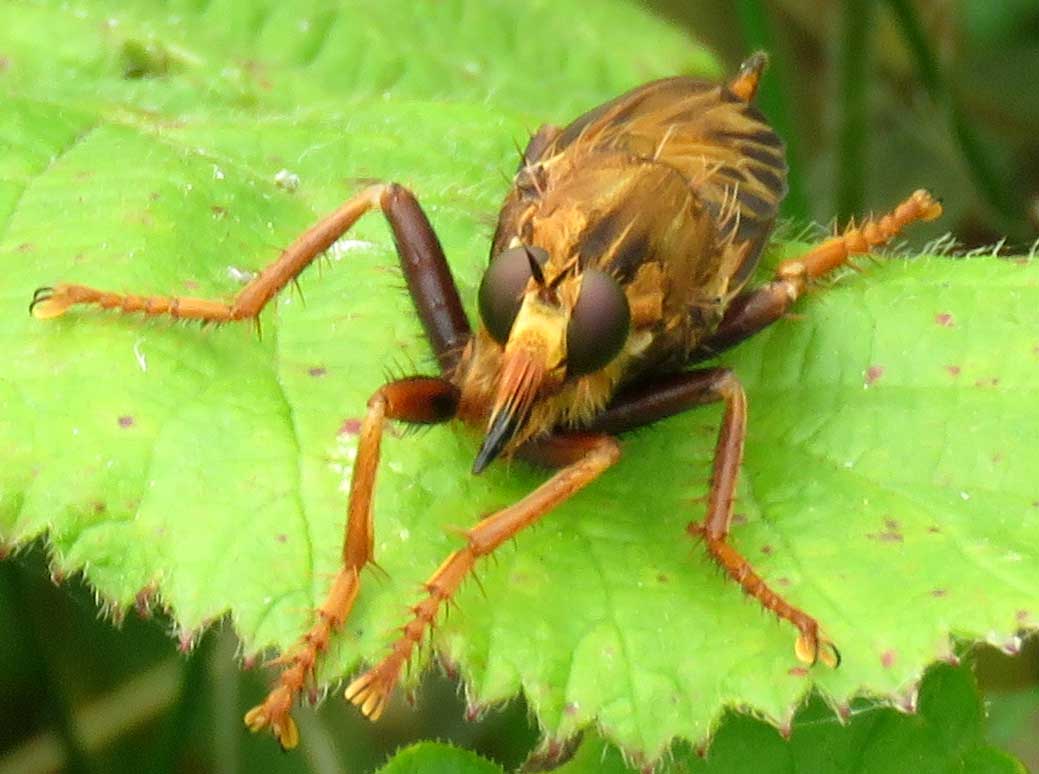 |
 |
.jpg) |
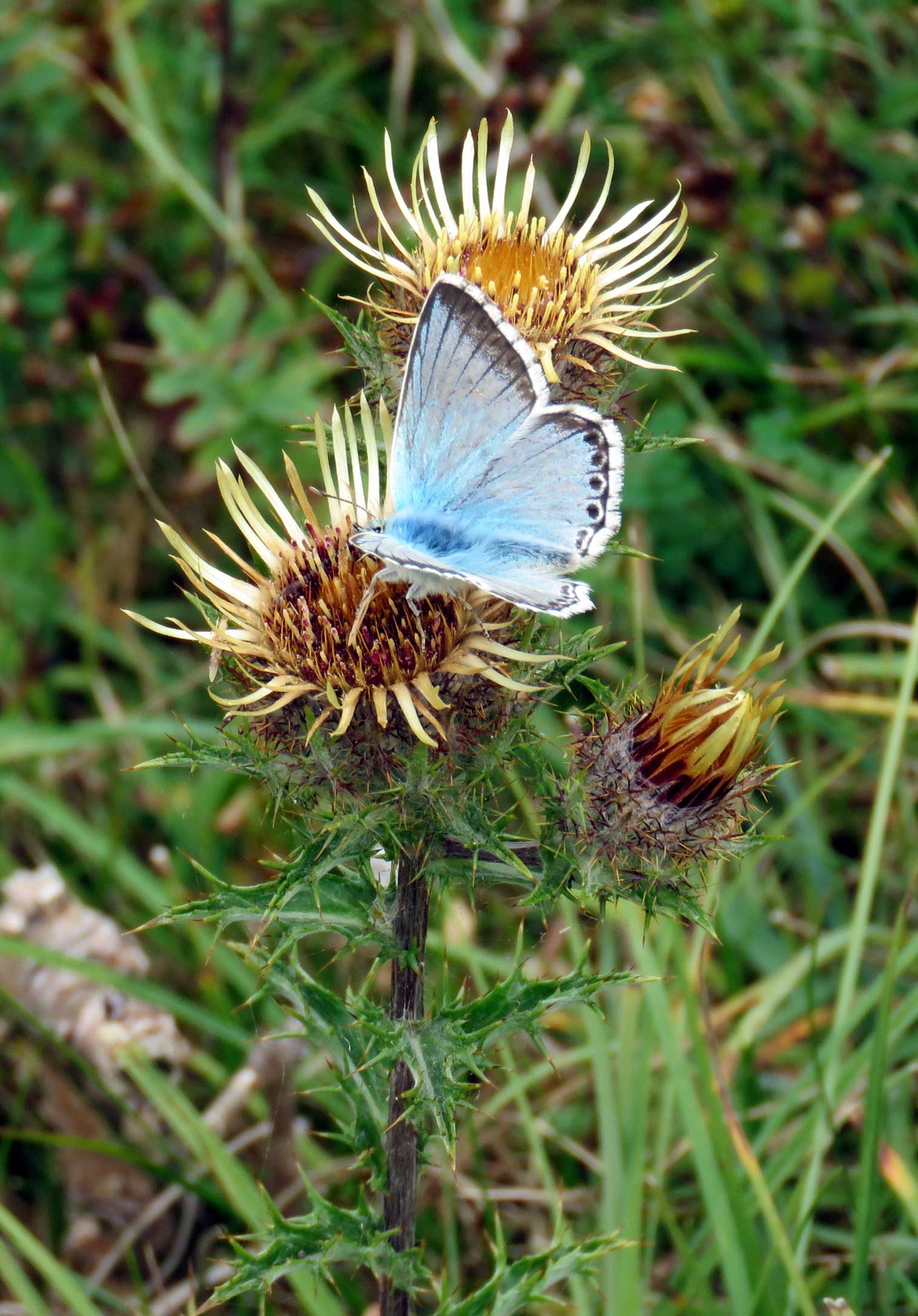 |
|
|
|
|
|
Two
robber
flies were noted: the smaller Robber
Fly, Machimus atricapillus,
on the southern steps and the much larger Hornet
Robber Fly,
Asilus
crabroniformis, on the top meadow.
Both
of these flies will prey on butterflies as would a
Southern
Hawker (dragonfly)
which flew over the lower slopes and seen from the middle slopes.
In
the top meadow two Goldfinches
chirmed to each other amongst the seed heads and thistles
and saucer-like dead heads of the Greater
Knapweed.
9 August
2015
Mill
Hill in glorious sun amongst the Chalkhill Blues and the company of some
nice butterfly people from Cambridge. They pointed out some Silver-spotted
Skippers (3) I had missed, but I couldn't
help them with their target species of Adonis
Blue. Blow me down, a few minutes after
they left I found a freshly emerged male of that species. Other highlights
among 19 species of butterfly
were at least 3 Clouded Yellows, quite a few Wall and a very faded Dark
Green Fritillary. (Lindsay Morris)
7 August
2015
My
Mill Hill transect today showed plenty of Walls: Brimstone, Chalkhill Blue
39, Comma, Common Blue 13, Essex Skipper 4, Gatekeeper 30, Meadow Brown
32, Peacock 10, Red Admiral 6, Small Heath, Small Skipper, Small White
3, Wall 9, Humming-bird Hawk-moth, Lesser Treble-bar 2.
More a low mist than just overcast, inimical for the appearance of butterflies, but not the strong shadows to hinder photography. Nevertheless the weather was unfavourable as all the vanessids and most of the butterflies were in hiding. On the lower slopes of slopes of Mill Hill, the butterflies need mostly be disturbed to be seen in flight and then only 26 Meadow Browns, an estimated 15 Gatekeepers, six Wall Browns and just five male Chalkhill Blues, a clear Clouded Yellow, a possible Peacock and a few 6-spotted Burnet Moths were seen in the transect acre. The pyralid micro-moths Pyrausta despicata and Pyrausta nigrata, were both seen on the lower slopes. A Yellow Shell Moth was seen in a scrubby part of the transect as the northern end has now become. The middle and top slopes only added more Gatekeepers and Meadow Browns and two or three male Common Blues.
1
August 2015
A
sunny day brought out the vanessid
butterflies
on the Buddleia,
Hemp
Agrimony and Marjoram
on the middle slopes of Mill Hill: frequent Peacocks,
frequent Red Admirals,
two Painted Ladies
and a Comma.
Gatekeepers
and Meadow
Browns
were
widespread and frequent
as expected. Over a dozen Small/Essex Skippers
were spotted in the long vegetation where they were tricky to identify
which species and this was not possible. Two Speckled
Woods were spotted in the shade. The white
butterflies were patchy and occasional: Green-veined
White, Large White, Small Whites, one
Brimstone
were noted on the middle slopes and two Marbled
Whites amongst the Tor Grass on the lower
slopes. Frequent Wall Browns
(15+) were widespread all over Mill Hill. They looked like a fresh appearance
of the second brood. A Holly Blue
was spotted on the hedge by the road and cattle grid, and frequent Common
Blues
in the top meadows (looking more like a rough pasture). As I took a route
through the top scrub before descending through overgrown paths to the
lower slopes from the north, the 22 male Chalkhill
Blues for 75%
of the transect acre was extremely disappointing.
A single Small Heath
was clearly seen on the lower slopes.
If
this seems like a list the continual appearance of a variety of butterflies
made it so. The prime spots for butterflies were on the middle slopes as
the narrow path passes a large clump of Buddleia
and soon afterwards the open area of Hemp
Agrimony and Marjoram.
A possible Brown Argus
was rejected but a small moth
Pyrausta purpuralis included on the
middle slopes. 6-spotted Burnet Moths were
substantially reduced in number from my last visit but were still frequently
seen in the afternoon on the purple flowers.
A large blue
dragonfly
in the scrub was probably a Southern Hawker.
A Robber Fly Machimus atricapillus,
landed amongst the stridulating grasshoppers
on the lower slopes.
Adur
Butterfly List 2015
 |
Grasshoppers
were stridulating and common on
Mill Hill
On
Silverweed
on the southern steps.
|
 |
 |
 |
|
|
|
|
A trip
to Mill Hill was in order as the wind died down. It was still cloudy approaching
the peak time (this year may be two weeks
behind schedule?) for butterflies.
Even it was still pre-peak the numbers of butterflies were tragically disappointing.
The first butterfly seen was a male Common
Blue on the top southern part. The one
acre transect on the lower slopes only produced
four magnificent Peacock Butterflies,
one Comma,
11 male Chalkhill Blues,
frequent Gatekeepers
(40+), frequent Meadow
Browns
(15+),
frequent Six-spotted Burnet Moths (25+),
the pyralid
micro-moths
Pyrausta purpuralis and
Pyrausta
nigrata, small Robber
Fly Machimus atricapillus, a Common
Darter (dragonfly),
and a Dark Bush Cricket amongst
the abundant and noticeable grasshoppers.
The
middle and top slopes of Mill Hill added more Meadow
Browns,
Gatekeepers,
a
few (5+) more Peacock
Butterflies, a few (2+) Essex
Skippers, a few whirring Silver
Y Moths,
a
male Common Blue,
a Painted Lady
and a pair of Wall Browns. Conditions
were inimical to butterfly spotting and the low numbers were partly explained
by the butterflies hiding and needing to be disturbed in the early afternoon
on a cloudy day.
 |
 |
 |
|
|
|
|
The Chalkhill Blues rarely settled and were noted visiting Eyebright and Bird's Foot Trefoil flowers. Most butterflies were not active in their search for nectar flowers, except the pristine Peacocks first discovered basking on Ragwort and later spotted on Greater Knapweed. The Six-spotted Burnet Moths visited purple flowers almost exclusively: Greater Knapweed, Hardheads (=Lesser Knapweed), Dwarf Thistle, Wild Basil. Unusually, the prevalent Hemp Agrimony and Marjoram on the middle slopes did not attract any butterfly activity but by that time a big cloud had made it shady and cool. The Ragwort was very frequently found with the black and yellow caterpillars of the Cinnabar Moth crawling over its leaves and stem.
Near the cattle trough there was large clump of Fleabane, not normally seen on Mill Hill and a few Restharrow which is also unusual for this location. Round-headed Rampion was flowering on the upper plateau.
23
July 2015
My
Mill Hill transect gave me a second brood Brown
Argus.
The Marjoram and Hemp Agrimony at the top of the hill were covered in Peacocks,
Red Admirals, a Painted Lady and a male and female Dark Green Fritillary.
I have only recorded one DGF in the previous 4 years and wonder where they
have come from. Moths: Lime-speck Pug larva (Eupithecia centaureata)
on Knapweed , many Silver Ys and Six-spot Burnets, Small Purple and Gold,
Straw-barred Pearl. My count: Brown Argus, Chalkhill Blue 31, Comma 1,
Dark
Green Fritillary 2, Essex Skipper, Gatekeeper
73, Green-veined White 3, Large Skipper, Large White, Marbled White 11,
Meadow Brown 40, Painted Lady, Peacock 6, Red Admiral 8, Small Tortoiseshell,
Small White 4. (Colin
Knight)
21
July 2015
I
made a visit to Mill Hill, but this was curtailed by a combination of an
overcast day and Strong Breeze (Force
6 gusting to Force 7). Butterflies
were almost all hiding but I managed to disturb Gatekeepers,
Meadow
Browns and
Small
Skippers, one Marbled
White and Peacock
on
the southern top part of the hill. It was going down to lower slopes when
I changed my mind half-way along the path after I had seen a Chalkhill
Blue and scores of Six-spotted
Burnet Moths
on Greater
Knapweed flowers.
 |
 |
 |
|
|
|
|
A Swift flew over Mill Hill whilst a Skylark sang persistently. Of special note was my first Round-headed Rampion flower of the year near the path that winds its way through the lower slopes. Toadflax was also seen in flower for the first time this year.
19
July 2015
Spectacularly
a pristine Dark Green Fritillary
stole the butterfly show in the sunny meadow
south of the Reservoir on Mill Hill. It was blown a bit on the breeze and
fluttered from one Greater Knapweed flower
to another quite rapidly. Fourteen other butterfly
species included five male Chalkhill
Blues, new Peacocks,
new Comma Butterflies
and the whirring Six-spotted Burnet Moths
seen for
the first time this year. The predatory Robber
Fly, Machimus atricapillus,
was seen at least twice on the lower slopes of Mill Hill.
Lindsay
Morris spotted a Small
Copper Butterfly and two Peregrine
Falcons overhead.
Butterfly
List for the Day
 |
 |
 |
|
|
|
|
A Fleabane flower was another surprise discovery in the Greater Knapweed meadow south of the Reservoir on Mill Hill. Musk Thistle seemed to be scarce this year and one flower on three windswept plants near the ridge (to the lower slopes) were all that were seen. Teasel was flowering and there were hundreds of Ragwort plants.
14
July 2015
On
a cloudy humid day I made a trip to Mill Hill
for the purpose of seeing if the Chalkhill
Blues were yet in flight. I got lucky
just as I had forgotten the quest, I spotted what appeared to be a fresh
specimen amongst the undergrowth. By that time, I noticed the change in
the season with appearance of the flowers
of Carline Thistle,
Small
Scabious, Dwarf Thistle, Autumnal
Hawkbit and
Wild
Basil on the lower slopes. And Hemp
Agrimony,
Marjoram,
Field Scabious, Melilot, Lady's Bedstraw,
Perforate St John's Wort, and
Greater Knapweed on the middle and upper
slopes. At least one of the distinctive Panorpa scorpion
flies
was seen amongst the scrub, and a Yellow
Shell Moth.
Butterflies
were again patchily distributed over Mill Hill with more of them on the
upper part than the lower slopes. The cloudy day meant that that there
were not so many in active flight, but I managed to see over fifty each
of Gatekeepers and
Marbled
Whites, over thirty Meadow
Browns,
a few Small Skippers,
one Small Tortoiseshell,
and at least one splendid Large White Butterfly.
There were also a few small pyralids
Pyrausta despicata flitting over the
lower slopes with at least one Small Heath
Butterfly. The stripy
caterpillars of the Cinnabar Moth were
common (100+) on Ragwort
on the upper part of Mill Hill, mostly near the Reservoir.
6 July
2015
Marbled
White Butterflies were common
with over a hundred seen but patchily distributed over Mill Hill with 49
counted in the transect acre
on the lower slopes. Meadow
Browns
30+
(15 in transect acre), Gatekeepers
25+ (9 in transect acre), Small Heaths
(8+) with a few Small
Whites, a few Large
Whites, two Brimstones
over
the lower slopes, at least three definite
Small
Skippers on the middle slopes, and one
Painted
Lady in the upper meadow brought the tally
to nine species
on a pleasant day. The tenth species was
my first ever confirmed Ringlet
from the upper meadow (north of the car park) of Mill
Hill Nature Reserve. (The Ringlet
had been suspected in recent years but I was never sure.)
There
were occasional micro-moths
including the Small Purple-barred Moth
Phytometra
viridaria and the pyralid
Pyrausta despicata over the lower
slopes and
Silver Y Moth
amongst the overgrowth up the top of the hill. A Dark
Bush Cricket,
Pholidoptera griseoaptera,
was spotted on the edge of the scrub.
New
plants seen in flower for the first
time this year were Dwarf Thistle
and Small Scabious
on the lower slopes, and Marjoram
on the middle slopes. Greater Knapweed
was flowering and their big purple flowers attracted flying insects including
butterflies,
beetles,
bees,
hoverflies
and stripy wasps.
The
northern end of the lower slopes which in past years has been promising
for blue butterflies is now almost completely overgrown with the invasive
Privet.
3 July
2015
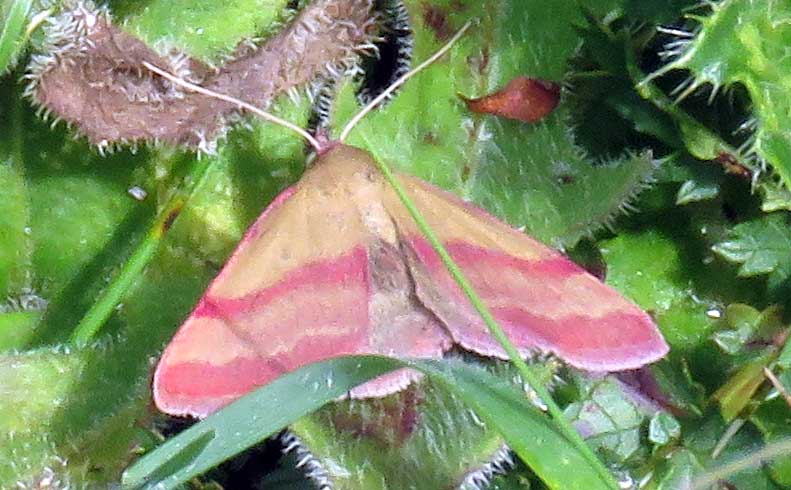
Small Purple-barred Moth |
 |
|
|
|
It
was too hot and humid in the middle of the day for a visit to Mill Hill.
The butterflies were lively and common, with
Marbled
Whites leading the way with 60+ (49 in
the transect acre
on
the lower slopes), Meadow
Browns
30+,
Small Heaths 20+,
my first two Gatekeepers
of the year, at least two Brimstones,
three Small Tortoiseshells,
one surprising Holly Blue,
one Common Blue,
at least one Large White
and a close-up look at a Small White, four
Cinnabar
Moths and three pyralids,
two
Pyrausta
purpuralis, and one Pyrausta
despicata. A Dark
Bush Cricket,
Pholidoptera griseoaptera,
was spotted and a small white patterned micro-moth
identified as Eucosma
campoliliana.
| The Crow with a red mouth was a fledgling born this year and some of the other six birds may have been youngsters as well. |
 |
Then the heat and humidity got the better of me and I turned for home.
1 July
2015
My
Mill Hill transect in the morning was bursting with Marbled Whites and
the first Gatekeepers: Adonis Blue, Brimstone, Gatekeeper 6, Marbled White
74, Meadow Brown 10, Red Admiral 2, Small Heath 19, Whites 2, moths: Cinnabar,
Common Purple and Gold 4, Marbled Orchard Tortrix, Satin Grass-veneer,
Straw-barred Pearl, Yellow Shell plus a Mullein Moth caterpillar. (Colin
Knight Report)
29
June 2015
On
a sunny Moderately Breezy (Force
4) day, I
cycled up to Mill Hill, locked my bicycle and walked to the lower slopes.
Butterflies
were very frequent and lively
led by the omnipresent Small Heaths 20+,
exceeded in numbers by Marbled Whites
30+, and accompanied by Meadow
Browns
20+,
a few male Common
Blues, a Brimstone
Butterfly, a Small
Tortoiseshell.
a
Cinnabar
Moth, a Mother
Shipton Moth and the pyralids
Pyrausta purpuralis and
Pyrausta
nigrata and
a small brown/fawn moth. The first Carline
Thistle appeared in flower
this year with still some of the dead plants from last year standing upright.
The miniature Squinancywort
was also seen in flower for the first time this year.
On the middle slopes I added more Marbled Whites (7+), Meadow Browns (8+) and Small Heaths (9+), two more Cinnabar Moths, a Brimstone Butterfly, a Small Tortoiseshell, a Common Blue and four Small Skippers Two Small Skippers were highly aggressive chasing away butterflies twice their size on numerous occasions (e.g. six times in 3 minutes). Field Scabious was flowering.
My attention was drawn to the melodious warbling from the scrub. This was a Whitethroat. On the open middle slopes the songs of the Skylark and Song Thrush competed with the stridulating of the grasshoppers and noise of the breeze blowing the long grasses about and the traffic on the A27. The drone of the small aeroplanes was negligible in comparison.
Meadow
Cranesbill, Knapweed Broomrape
Upper
Mill Hill (south)
As
anticipated the first Marbled Whites
of the year came out in the sun on the lower slopes of Mill Hill amongst
the Tor Grass and Brambles.
At least seven were seen simultaneously. Small
Heath Butterflies were omnipresent with
22 counted in the transect acre.
Meadow
Browns
were occasional with about nine. The blues were represented by four Common
Blues
including a large male which could have been mistaken for an Adonis.
There were occasional micro-moths including the pyralids
Pyrausta purpuralis and
Pyrausta
despicata. .
Adur
Knapweeds
Lower Slopes
New plants in flower included Perforated St John's Wort, Agrimony on the lower slopes and Welted Thistle next to the southern steps.
Belladonna
My Mill Hill transect gave me Marbled White 12, Meadow Brown 10, Small Heath 15, Adonis Blue 2, Brimstone, Common Blue 2, Red Admiral, Small Tortoiseshell 7, an unidentified White, Small Purple and Gold Moth 2, Cinnabar 2. (Colin Knight)
19
June 2015
Intermittently
cloudy with a blue sky. Unfortunately it was more cloudy than not
when I visited Mill Hill around the middle of the day. At the top of the
Pixie
Path (south side of the bridge to Mill Hill) a female Stag
Beetle crawled across the narrow footpath.
At the top of Chanctonbury Drive (SE of the bridge), the grass had been
mown along with the Bee Orchid
which did not survive and there were no butterflies
visiting.
At
the top of the southern steps I disturbed a Cinnabar
Moth which flew away and disappeared.
On the edges of the steps I noted both Silverweed
and Creeping Cinquefoil close
to each other but in separate habitats.
A
much shredded male Adonis Blue appeared
immediately on the lower slopes. All three males seen were badly damaged,
in contrast to a generally fresher 13 (11+2) Common
Blues
in the transect acre.
Quickly, I spotted my first five Meadow
Browns
of the year on the lower slopes. Small
Heaths seemed to be everywhere and a constant
presence, but the transect count
only came to 18, with two pristine Small
Tortoiseshells, two yellow Brimstone
Butterflies and a Treble-bar
Moth.
Mill Hill
For the first time this year, I climbed the northern steps and disturbed a probable Peacock Butterfly. By this time it was cloudy and the all the butterflies were dormant apart from those I disturbed another Small Heath, a large Meadow Brown, and spotted a resting female Common Blue. On the top overgrown meadow (now looking like a neglected cow pasture) two Common Blues quarrelled. Passage was difficult and I expect there were many more. On the top plateau and in the same place as before I scared a Skylark into rapid flight. On the breeze-blown hill there were two more Small Tortoiseshells, two Red Admirals and two Large White Butterflies.
Approaching mid-summer and more plants began to flower: noting the almost complete demise of the Horseshoe Vetch, two late Dog Violets, the frequent Dropwort, the first of the slender Yellow Wort, the ground hugging Self-heal and one newly budding Carline Thistle. On the middle slopes there were yellow swathes of Bird's Foot Trefoil and Yellow Rattle. On the top of the hill a few Greater Knapweed appeared in flower, as well as the unusual appearance of the parasitic Knapweed Broomrape, Orobanche elatior, that grows brown and upright. There seemed to be more of these brown spikes than in previous years. On the southern top flattish part of Mill Hill, there were masses of Ragwort, not yet in flower, hundreds of plants instead of the occasional one in disturbed soil. At the best northern end of the lower slopes, Privet is extremely invasive blotting out the Horseshoe Vetch for good. One Robin's Pin Cushion was spotted.
18 June 2015
Skylark
Photograph
by Etienne Fournier
My Mill Hill transect yielded Adonis Blue 14, Grizzled Skipper, Large Skipper, Marbled White, Meadow Brown 4, Painted Lady 3, Red Admiral, Small Heath 22, Small Tortoiseshell 2, Cinnabar, Straw-barred Pearl and an unidentified green larva. Itís a second bad year in succession for the Adonis Blue, the worst since I started recording in 2011. The second brood should be better. Small Heath are having another good year, they have been steady since 2011. The Grizzled Skipper is very late, this is week 12 of the transect year and the latest I have previously recorded one is week 9. (Posted by Colin Knight on Sussex Postcards)
14
June 2015
An
overcast mid-morning was not the best time for seeing Mill Hill's butterflies,
although I did record several Adonis Blues, Small Heaths and a Brown Argus.
Two recently-fledged Song Thrushes, and singing Yellowhammer, Skylark,
Linnet and Whitethroat, with a Cetti's Warbler still singing from a ditch
line to the east. A Kestrel hunting. Stars though were two Adders
at the bottom of the slope.
12
June 2015
I
did my Mill Hill transect: Adonis Blue 9, Brimstone, Common Blue 2, Meadow
Brown, Painted Lady, Small Heath 10, Small Tortoiseshell, Silver Y, Cinnabar
2, Burnet Companion, Common Yellow Conch, Straw-barred Pearl. Plus a black
Adder.
(Colin Knight bit.ly/1f7c2mZ)
7 June
2015
With
large white Cirrus clouds
ambling across the blue sky, the weather alternated between sunshine and
shade, with shade winning out 70/30. I spotted
my first grasshopper before I consciously
heard the stridulating over the traffic noise and a persistent Song
Thrush. But
at least the near gales had died down.
 |
 |
 |
 |
|
|
|
|
|
On the lower slopes of Mill Hill, Adonis Blues dominated and exceeded all the other butterfly species in numbers. As usual the bright blue males were most easily seen and out of a total one acre transect count of 44, 39 were males with only five females seen. Other butterflies present were 13 Small Heaths, at least six Brimstones (including three males sparring together), one probable Grizzled Skipper, two male Common Blues, a probable Yellow Shell Moth and lastly a faded Painted Lady. The Horseshoe Vetch had diminished and new flowers noted included Hawkbits, Dropwort, Fairy Flax, Eyebrights, Creeping Cinquefoil (first record on Mill Hill), Wild Thyme, and Privet. Just the leaves of Yellow Wort appeared. A Kestrel soared over the lower slopes, and there was a flock of more than a dozen Jackdaws congregating. Magpies could be heard cacking and a Chaffinch sang. On the southern steps I spotted two distinctive caterpillars on Great Mullein leaves. Predictably, I identified them as the unmistakable larvae of the Mullein Moth.
Mill Hill
I ventured up to the breeze swept top plateau where I spotted a male Common Blue Butterfly, and disturbed two or three Wall Browns whilst looking at White Campion, and scared a Skylark into rapid flight. Most of the yellow on the exposed top of the hill were Bulbous Buttercups, but there was some Horseshoe Vetch amongst the dried cow pats south of the upper car park.
28
May 2015
I
did my weekly Mill Hill transect with the following results: Adonis Blue
15, Brimstone 1, Common Blue 1, Green Hairstreak 1, Grizzled Skipper, Peacock
1, Red Admiral 1, Small Heath 3, Wall 1, Cinnabar 1, Violet Cosmet 1, Common
Yellow Conch 1. (Colin Knight www.seapic.com)
Butterfly
Conservation
25 May 2015
Fox
on
the lower slopes of Mill Hill
in
the early morning at 7:00 am
Photograph
by Etienne Fournier
24
May 2015
 |
 |
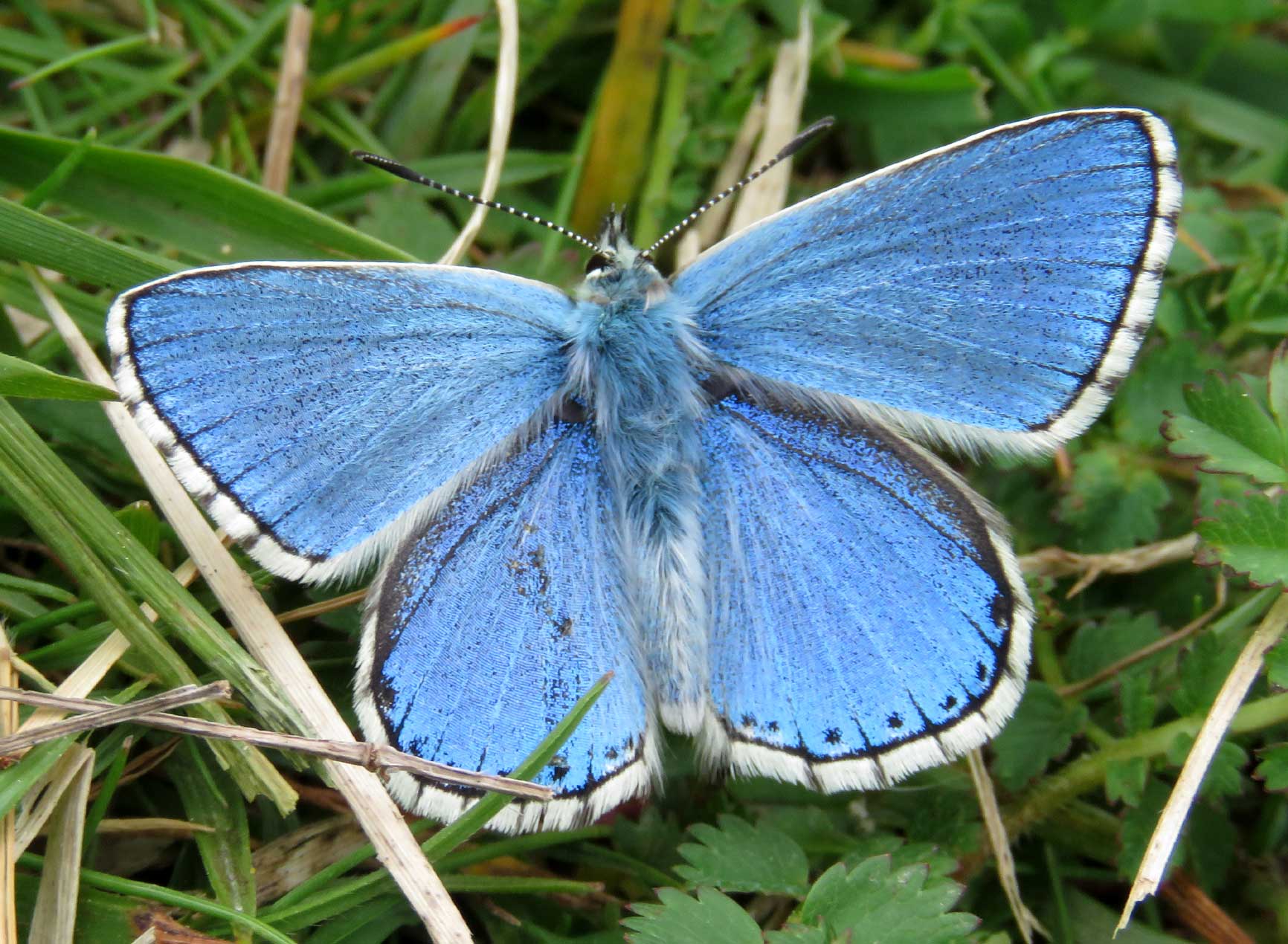 |
|
|
|
|
A Buzzard
descended from the low-flying clouds and a Kestrel
hovered over the lower slopes of Mill Hill. There were more butterfly watchers
than actual butterflies,
but I did manage a glimpse of my first Small
Heath Butterfly of the year as well as
my first Mother Shipton Moth.
The overcast conditions made for a paucity of butterflies in flight, but
there were plenty (15+) of human feet to disturb 15+ Adonis
Blues, including
a mating pair, two or more male Common
Blues, at least one very faded Dingy
Skipper and at least three Brimstone
Butterflies. The first butterfly I spotted
was a bright Peacock and
later a surprise Red Admiral showed
briefly. The Horseshoe Vetch was
at its peak (98%).
21
May 2015
A
Cuckoo
called repeatedly from below Mill Hill and I could clearly hear it above
the noise of the traffic. It was my first Cuckoo
of the year. A Buzzard
soared above and a Kestrel
was seen hovering as well as a flock of seven or more Jackdaws.
The characteristic dipping flight was a Green Woodpecker (or it
could have been a Jay?)
flying over the bottom hedge and into cover of some Blackthorn amongst
the scrub.
 |
 |
 |
 |
|
|
|
|
|
On the lower slopes of Mill Hill, the Horseshoe Vetch was virtually at its peak (90%). That made up for the relative paucity of butterflies but they did include my first female Adonis Blues with three of the dozen or so males seemed more intent of sparring amongst themselves and quarrelling with a lone Brown Argus and a single male Common Blue. A Brimstone Butterfly patrolled the bottom hedgerow. Dingy Skippers were frequently seen with about a dozen actually noted but a Grizzled Skipper could not be confirmed. A Green Hairstreak flitted amongst the Brambles. There was handful of Peacock Butterflies and one was so badly damaged it looked like a Comma in silhouette of its underside. A single Cinnabar Moth was spotted on two occasions. And a Large Red Damselfly.
Wild plants spotted in flower on Mill Hill included a few of both Dog Violets and Sweet Violets, Red Valerian noted about a week before by Mill Hill Road, Meadow Buttercups and Silverweed on the upper part of the hill, Wild Mignonette on the lower slopes at the southern end, and the first two Eyebrights at the northern end.
Colin
Knight added a Silver
Y Moth and a Small
Heath Butterfly to the list, found on
the lower slopes of Mill Hill.
Jan
Charteris photographed the small moth
Scoparia
pyralella,
sometimes called a Meadow Grey, (I
had noted this moth before in 2007.),
and
a Mother Shipton Moth as
well as a Common Heath,
Ematurga
atomaria, found on the lower slopes
of Mill Hill.
17
May 2015
 |
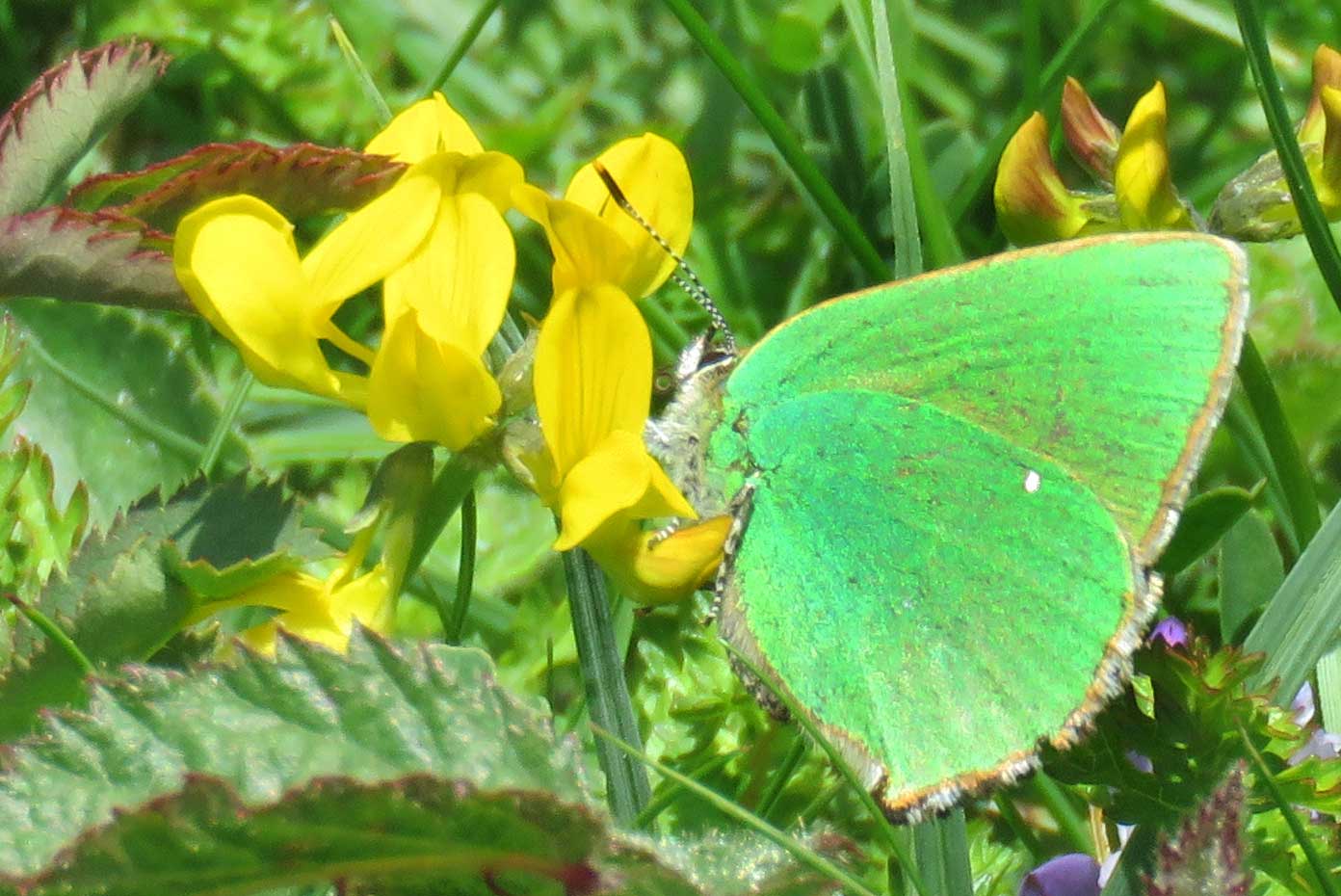 |
 |
 |
|
|
|
|
|
A Kestrel
soared over Mill Hill just after midday. It was seen hovering and then
twice the bird of prey descended on the lower slopes but both times emerged
without any visible prey. Weak sunshine on a breezy afternoon brought out
frequent butterflies
including the bright blue of my first male Adonis
Blue of the year. It was the first of
about a half a dozen and there were a few male Common
Blues also seen for the first time of
the year. These Common Blues
sparred with the first of the year Brown
Argus
which
were very distinctive perched on the taller herbs including Horseshoe
Vetch. Both strong-flying Brimstone
Butterflies
and ground flitting Dingy
Skippers were frequently seen, occasional
Green
Hairstreaks, two Peacock Butterflies
with one each of a Grizzled Skipper and
Wall
Brown. Large moths
were represented by my first Silver Y and
an elusive and brightly coloured Cinnabar
Moth.
Carpets
of Horseshoe Vetch,
Hippocrepis
comosa,
were abundant but this dominant
flower
had not yet peaked as there were plenty of buds. The first Hawkbits
were seen and there were still a few Dog
Violets in flower.
At
the top of Chanctonbury Drive (SE of Mill Hill
Nature Reserve) two Speckled Woods,
two
Holly Blues
and a Large White Butterfly
appeared.
17
people turned out to hunt for the Mill Hill May "Big 5" (Adonis Blue, Green
Hairstreak, Wall and Dingy and Grizzled Skipper) on Sunday. Previous year
Mill Hill May BC events seem to have coincided with unseasonal wintery
type days! This looked to be heading the same way as we gathered at the
top of the hill in a seriously nippy wind and jackets went on and hoods
went up. It looked like the big 5 was in fact a big overpromise! However,
as we got to the bottom of the slope the sun broke through and Ellie spotted
the first butterfly - a lovely Green Hairstreak which perched obligingly
for everyone to see and photograph. We saw 12 species including all the
big 5, although not everyone managed to see the Wall. I was one of the
unlucky ones and although I was supposed to have been the leader in fact
I wasn't first onto any of them. Luckily we had some sharp eyed under 16's
in Ellie, Rosie and James who spared my blushes.
I
was also delighted to hear the nightingale on the site and a cuckoo calling
away in the valley below.
We
didn't do a count but the full list was Adonis Blue (10s), Common Blue
(1), Green Hairstreak (10?), Small Heath (1-2), Dingy Skipper (low 10s),
Grizzled Skipper (C5 - 10), Brimstone (1 - patrolling backwards and forwards),
Small White (1), Peacock (1 - 2), Wall (2), Comma (1), Red Admiral (1).
There could also have been Small Tortoiseshell caterpillars which I didn't
see so it may have been 13 species. These are my guesses at numbers based
on what I saw! Ellie, Rosie and James probably saw loads more!
Some
Peacock caterpillars and a female Adonis Blue which he patiently photographed
as it emerged with crumpled wings and crawled to nectar on flowers for
the first time.
Thanks
to everyone for coming along and contributing to a great butterfly hunting
team effort. If anyone has any other photos please send them to the sightings
page! (Chris Corrigan) Butterfly
Conservation Sussex
15 May 2015
Jackdaw
mobbing a Buzzard over Mill Hill
Photograph
by
Etienne Fournier
13
May 2015
While
it was sunny, Mill Hill gave me 24 Dingy Skippers, 4 Small Heath, 3 Wall,
3 Common Blue, a Clouded Yellow (possibly 2), Brimstones, but unlike others
present I couldn't find Grizzled Skipper or Green Hairstreak. Ah, the ones
that get away... Nightingale was a lovely backdrop of sound too. (Lindsay
Morris) Butterfly
Conservation
At Mill Hill I found Adonis Blue (first in Sussex this year), Dingy Skipper, Green Hairstreak, Peacock, Wall, Grizzled Skipper, Brimstone, Cinnabar, Hook-streak Grass-veneer, Lesser Treble-bar and a large black Adder. (Colin Knight www.seapic.com) Butterfly Conservation
10
May 2015
It
was overcast around midday when I cycled up to the lower slopes of Mill
Hill, to try out my newish camera on any butterflies
that might be around. Alas as expected the dull conditions did not encourage
any butterflies and my twenty minute one acre transect walk produced just
four skippers
and two of these were Dingy Skippers
more intent on courting than settling for a photograph. A yellow male Brimstone
Butterfly patrolled the bottom hedgerow.
Two moths
were disturbed: a Treble Bar
and colourful Cinnabar Moth.
A feint glimmer of sunshine and I took the opportunity to practice using
my Nikons on the stationary wild plants, typically the now flowering Horseshoe
Vetch, as the light had improved.
 |
 |
 |
 |
|
|
|
|
|
A Kestrel soared over the blue sky and more Dingy Skippers appeared and I saw at least twenty, but some may be the same ones so there were at least a dozen, possibly many more visiting Horseshoe Vetch and landing on Bramble leaves after their amorous encounters. Two pristine Peacock Butterflies flew in tandem and landed on a Hawthorn flower. A gigantic white butterfly flew over my head and searched for her Brimstone partner. More yellow Brimstones appeared: four were seen simultaneously in flight. A sudden glimpse of green against the yellow flowers was the first of the Green Hairstreaks of the day, probably about five individuals with two more seen by other visitors. A flurry of activity produced a Grizzled Skipper and another skipper in a brief flirtation. There were occasional crane-flies, Honey Bees, bumblebees, a Small Purple-barred Moth, Phytometra viridaria, frequent pyralid micro-moths Pyrausta nigrata, small running spiders including Nursery Web Spiders, one Crab Spider Xysticus, very small bees and flies. No blue butterflies were seen. No Pancalia micro-moths were located on daisies. The ground hugging Milkwort outnumbered the last of the Dog Violets. As I was about to leave the lower slopes of Mill Hill I spotted a Wall Brown Butterfly with closed wings. The small black pollen beetles Meligethes now congregated on the newly flowering Silverweed at the top of the southern steps.
7 May
2015
Mill
Hill transect on Thursday morning showed the first Common
Blues reported in Sussex this year: Brimstone
3, Common Blue 2, Dingy Skipper 13, Green Hairstreak 3, Green-veined White
2, Grizzled Skipper 2, Peacock 1, Small Heath 1. Later I saw plenty more
Dingies and Green Hairstreaks nectaring on Horseshoe Vetch. Moths seen:
Pyrausta
nigrata, P. purpuralis and Violet Cosmets on Daisies.
4
May 2015
Kestrel
over Mill Hill
Photograph
by
John Tomsett
There was substantial bird song (Song Thrush) from the scrub on Mill Hill, which compensated for the lack of butterflies on a cloudy Bank Holiday. If wasn't for the sharp eyes of a dedicated butterfly spotter, I would not even have found a Grizzled Skipper. Even the Pancalia and Pyrausta nigrata micro-moths were less than a handful each.
The Horseshoe Vetch was not yet flowering in abundance. Both the Common Striped Woodlouse, Philoscia muscorum, and the Pill Woodlouse, Armadillidium vulgare, were seen. The small bees were probably Lasioglossum sp..
1 May 2025
Milkwort,
micro-moth
Pancalia
leuwenhoekella,
Germander
Speedwell, Hawthorn (budding)
Milkwort,
Gold-fringed
Mason Bee on Horseshoe
Vetch Hippocrepis comosa
It was cloudy and without a glimpse of sunshine, no butterflies were seen at all on the lower slopes, but there was a lot of bird (Song Thrush) song, tiny micro-moths, lots of small crawling spiders, one or two small bees, the first flowers of Horseshoe Vetch, Hippocrepis comosa, fading Dog Violets, a few Milkwort, Cowslips, and a moderate breeze from the north. The firstHawthorn was budding as the Blackthorn blossom was fading. Small spiders were frequently seen scampering amongst the short and intertangled vegetation. I think one was a Pardosa hunting spider, but a tiny one looked like it was a web spinner.
Dingy
Skippers on Mill Hill
Photograph
by John Tomsett
 |
1
May 2015
Gold-fringed
Mason Bee (probable)
on Horseshoe Vetch on Mill Hill |
30
April 2015
An
all too brief lunchtime visit to the sunny, sheltered bottom of Mill Hill
produced 6 Grizzled Skippers, 8 Dingy Skippers, 4 Green Hairstreaks, Small
Heath and Wall amongst 8 species of butterfly. Horseshoe Vetch just coming
into flower - (Lindsay Morris) Butterfly
Conservation
A Kestrel captured a rodent, probably a Vole.
28
April 2015
Peregrine
over Mill Hill
Photograph
by
Etienne Fournier
25
April 2015
I
stopped off at Mill Hill for an hour early this afternoon more in hope
than expectation as it was cloudy and quite windy. However, the sun did
break through occasionally resulting in some butterfly activity on the
lower slopes (where it was sheltered). My final count was Peacock (2),
Large White (1), Small White (3), Grizzled Skipper (2), Dingy Skipper (2),
Green Hairstreak (1) and Small Heath
(1).
23
April 2015
Buzzard
over Mill Hill
Photograph
by Etienne Fournier
22
April 2015
With
a fresh breeze blowing (Force
5 gusting Force 7) steadily from the north-east
(ENE 72°)
the sheltered slopes of Mill Hill were a pleasant (>
15.1°C) place to visit. And for the first
time this year the species tally of butterflies
went into double figures with ten definites recorded and one probable recorded.
The edge of the copse at the top of Chanctonbury Drive (SE of Mill Hill)
hosted a Large White,
a Speckled Wood
and two Red Admirals
(first confirmed this year).
The
lower slopes of Mill Hill were showing the beginnings of spring flowers
with hundreds of Dog Violets
scattered over the short vegetation proving attractive to a dozen or so
active Peacock Butterflies.
A Brimstone Butterfly
sallied by, following the bottom straggly hedgerow. An orange butterfly
fluttered from the scrub and it was probably a Comma
Butterfly. But generally the small species
had to be searched for. I got lucky with a brief look at my first Green
Hairstreak of the year on a Bramble leaf, before another butterfly
of the same species distracted its attention.
 |
 |
|
|
|
A freshly emerged Dingy Skipper was chanced upon unexpectedly on some Ground Ivy and promptly flew off, where a single Grizzled Skipper made a repeated visit. A Clouded Yellow Butterfly was constantly active, flying at 12 mph or more over the more open slopes, rarely settling and only at a distance.
Small pyralid micro-moths Pyrausta nigrata were frequently (30+) seen and one other small moth recognised was a Small Purple-barred Moth, Phytometra viridaria. The micro-moth Pancalia was seen on a Daisy (I had forgotten how small these moths were.) Last, but not least, Wall Brown rose from the southern slopes after I left after over an hour.
A Linnet
sang
from a bare Sycamore tree.
21 April 2015
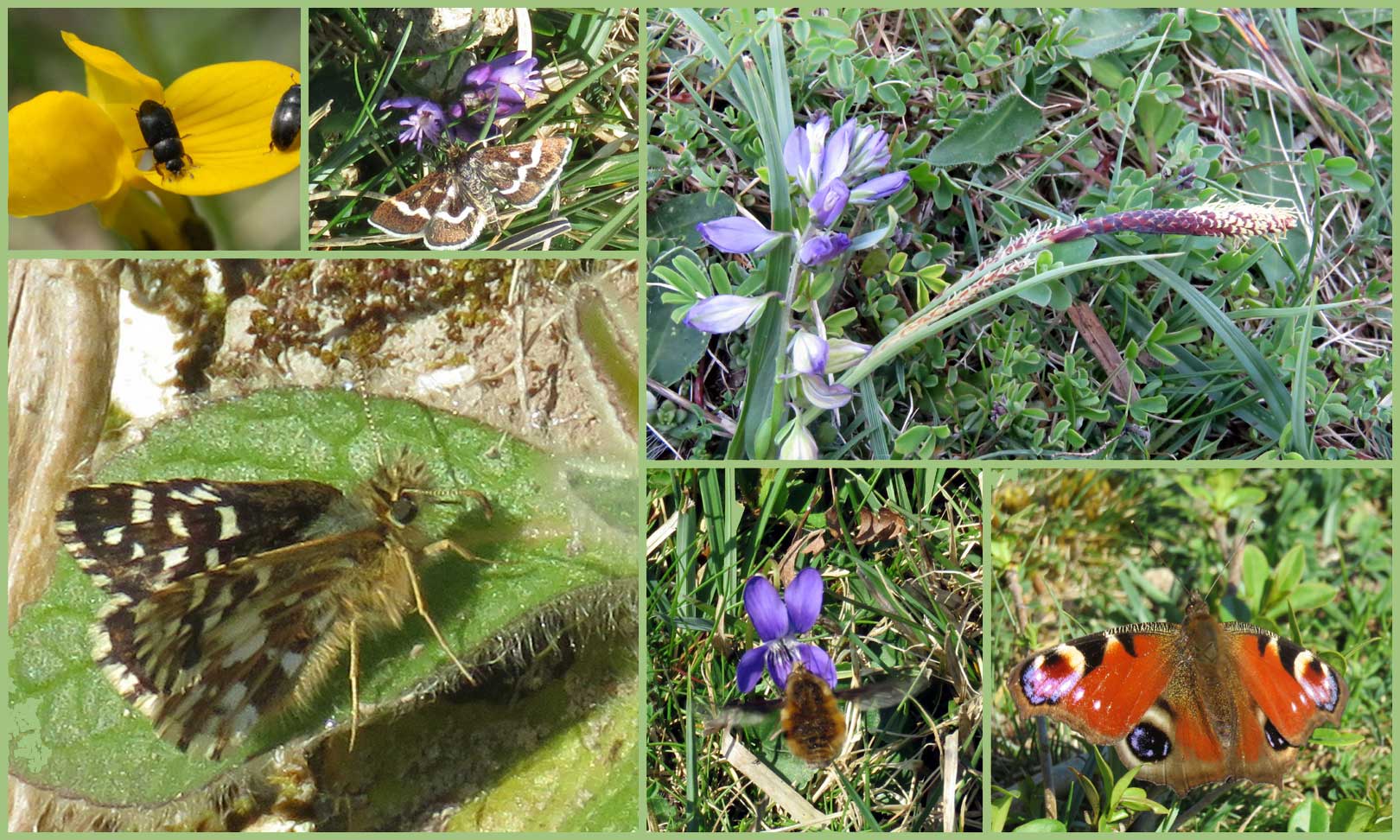
Completely
unplanned, my second visit to Mill Hill in as many days was rewarded by
a completely unexpected Clouded Yellow
Butterfly flying over the lower slopes.
They
have never been seen so early before and the only other early one was seen
in 2007.
Two
Grizzled
Skippers also made their first appearance
of the year on the lower slopes with scores of the pyralid
micro-moth Pyrausta nigrata
visiting the abundant Dog Violets and
the occasional
Sweet Violet. Other
butterflies
in flight in the late afternoon on the downs were frequent Peacocks,
and at least one Brimstone.
Common
Bee-flies were
frequently
seen and they were attracted to the violets
as well.
Adur
Butterfly List 2015
Quotes from Butterfly Conservation:
On a brief afternoon visit to Mill Hill, on the lower slopes we found at least 3 Clouded Yellow (in view at same time, but could possibly have been more), Also one Grizzled Skipper and several each of Common Purple and Gold (Pyrausta purpuralis) and Wavy-barred Sable (Pyrausta nigrata). (Jan-Paul Charteris)
Visited Mill Hill for the first time today. More butterflies seemed to be out compared with this time last year. Butterflies seen: Green Hairstreak, 2, (including one on blackthorn flower), Grizzled Skipper 4, Dingy Skipper 2, Orange Tip 4, Brimstone 4, Small Tortoiseshell 1, Comma 1, Peacock 2. (Simon Quin)
20 April 2015
My
first House Martin of
the year was seen flying to and fro over Mill Hill. On a breeze swept Mill
Hill there were occasional Peacock
& Brimstone Butterflies,
a few Small Whites
and Large Whites,
and one Small Tortoiseshell.
The relatively sheltered lower slopes hosted most of the butterflies
and were covered in thousands of Dog Violets.
The first handful of Milkwort
flowers could be seen amongst the short vegetation
where my first, of two, pyralid
micro-moth Pyrausta nigrata
flitted about. Just the two budding Horseshoe
Vetch flowers could be seen with their
accompanying pollen beetles.
There was another micro-moth amongst the Stinging Nettles next to
the southern steps. A Common Bee-fly
visited Dog Violets
over the southern slopes where scores of small spiders
could be seen out of the corner of my eye amongst the dense intertwining
leaves of the ground hugging vegetation. A small reddish bee
visited the patches of Ground Ivy.
I think the bee was the Red Mason Bee.
A single claw-like budding Bird's Foot
Trefoil was also spotted.
Quotes from Butterfly Conservation:
18
April 2015
This
afternoon I joined Andrew Burns on the lower slopes of Mill Hill at Shoreham.
The skippers are only just getting going, so it's still quite hard working
spotting them. After much searching the final score was Grizzled 7, Dingy
2. (Neil Hulme)
Mill Hill lower slopes and waterworks road below. Ten butterfly species including 3 Grizzled Skippers, Green Hairstreak, Orange Tip. Also an Adder. Purple & Gold and Cinnabar identified amongst several day flying moths. More Peacocks than anything else, a lot less Small Tortoiseshell than last week. (Lindsay Morris)
17
April 2015
Then
on to Mill Hill where I saw my first Grizzled Skipper and also found a
mating pair of Pyrausta purpuralis. (Mark
Cadey)
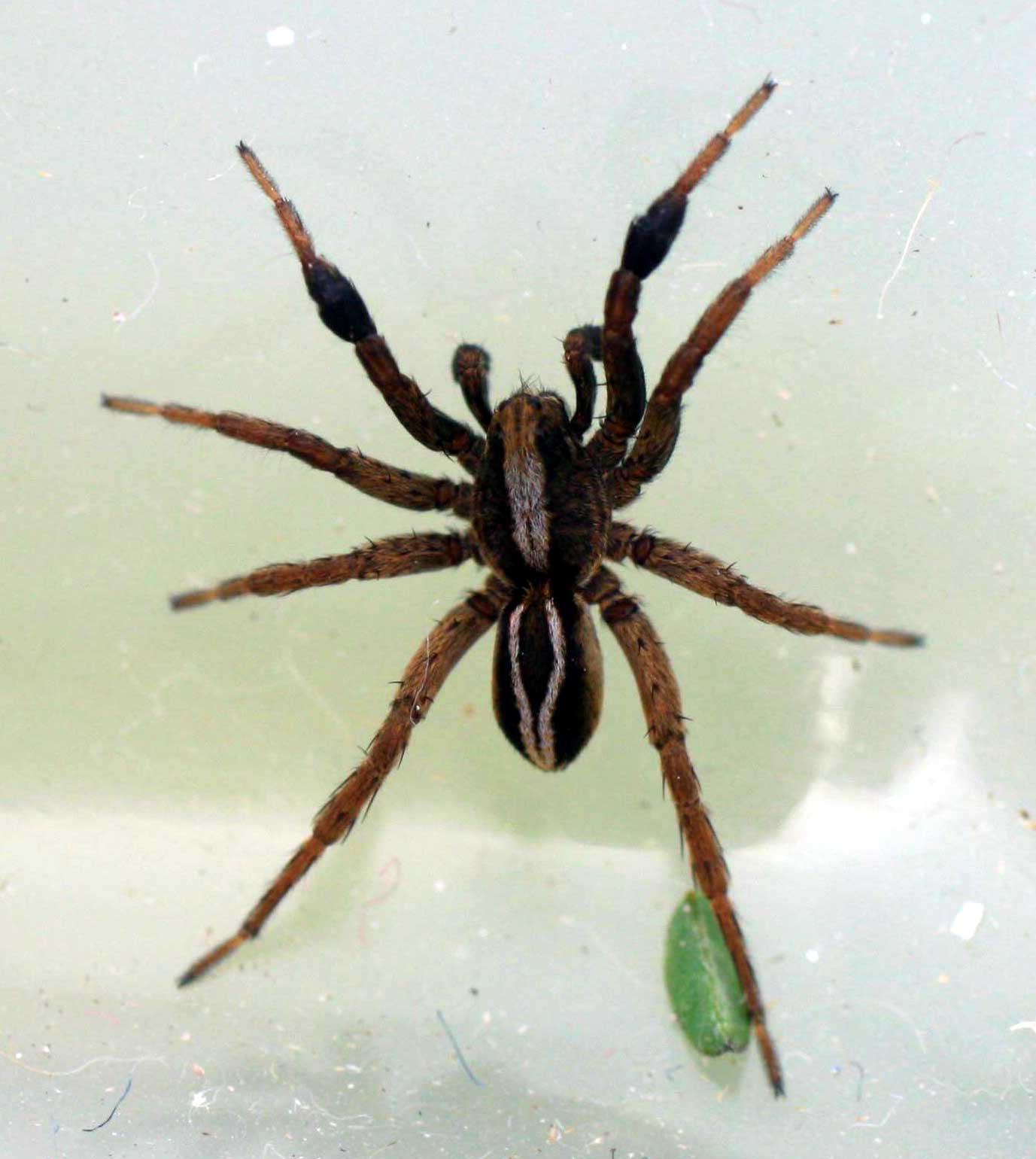 |
Alopecosa cuneata was a rather local species of spider found on Mill Hill. |
16
April 2015
I
did my Mill Hill transect this afternoon, recording 25 deg C at the bottom
of the hill. I found my first Green Hairstreak of the year and several
Grizzled Skippers, one of which roosted at 4:30 pm. I saw the same moths
I reported Tuesday: Violet Cosmet, Straw-barred Pearl, Wavy-barred Sable
& Common Purple and Gold plus a Little Roller. (Colin
Knight www.seapic.com)
14
April 2015
I
checked out Mill Hill this afternoon and found my first Grizzled Skipper
of the year laying an egg. I also found four moths: Violet Cosmet (Pancalia
leuwenhoekella), Straw-barred Pearl (Pyrausta despicata), Wavy-barred Sable
(Pyrausta nigrata) & Common Purple and Gold (Pyrausta purpuralis).
(Colin
Knight www.seapic.com)
12
April 2015
I
did my second transect at Mill Hill and saw just one Peacock, one Brimstone
and one Small Tortoiseshell, though more showed as the temperature rose
in the afternoon. I was pleased to find a new micro-moth, a Little Roller
(Ancylis comptana). John pointed out a Wavy-barred Sable (Pyrausta nigrata)
and Ian found a Brimstone Moth and a Straw-barred Pearl (Pyrausta despicata).
(Colin
Knight www.seapic.com)
6 April 2015
A rare
appearance of a Red Kite
over Mill Hill
Photograph
by Etienne Fournier
Easter
brought a spell of weak sunshine and an Adder,
Vipera
berus, basked in air temperatures
at 8.6 °C
in the afternoon. It was curled up on a bed of grass by the steps going
down to the lower slopes of Mill Hill.
It stuck its forked tongue out and slithered off under the thorn. The coiled
up snake was my first reptile of the year. I had only fifteen seconds before
it sensed me and quickly disappeared. This one seemed nearly as big as
a Grass Snake, at least 60 cm long. The opaque blue eye is perfectly normal
and happens just before the animal sheds its skin. There were a few bumblebees
and the inevitable Dung Flies
on the Alexanders,
but no still no butterflies in flight. The
first Dog Violets flowered
on the lower slopes of Mill Hill, with the Sweet
Violets much less than in previous years.
Green shoots of various herbs appeared through the layer of moss.
Adur
Violets
2 April 2015
Stoat
on Mill Hill
Photograph
by Etienne Fournier
27 March 2015
Kestrel
over Mill Hill
Photograph
by Etienne Fournier
7 March
2015
With
a brief appearance of the weak sun, I disturbed a butterfly
on the lower slopes of Mill Hill, but it flew off so rapidly that I did
not have a chance to identify it or chase it. I also spotted the first
two Sweet Violets
in flower this year on the upper part
of Mill Hill. The lower slopes were covered
in mosses.
Flora
on Mill Hill
Carline
Thistle, Mosses (with
a sprout of Milkwort)
Carline
Thistle, Ploughman's Spikenard (x2)
5 February 2015
I made my first visit to Mill Hill since 19 October 2014 and it was very much a spur of the moment decision because it was warmer than expected. At least until half way there when I turned back because of a sleet shower. But it stopped after ten minutes and continued on my cycle ride up the downs against a cold north wind. I had not expected to see anything of interest and it the usual path was too muddy to traverse without boots. I only ventured on the upper part of the Nature Reserve where the turf was still intact. A half dozen Robins, a Wren and Blackbird were all that was spotted with a few dead heads of the Teasel. I made it to the upper car park when I got caught again in a sleet shower which sent me cycling back home and I reached the town centre and there it was rain.
Mill
Hill Reports 2014
Adur
Butterfly List 2014
Mill
Hill Wildlife Reports 2014 (Link)
Mill
Hill Wildlife Reports 2013 (Link)
Mill
Hill Wildlife Reports 2012 (Link)
Mill
Hill Wildlife Reports 2011 (Link)
Identification
of Grasses (Link)
Mill
Hill Grasses
17+
SPECIES OF BUTTERFLIES DEPENDENT ON MILL HILL
FOR BREEDING:
(Estimated
numbers for Mill Hill Nature Reserve only
are in brackets)
| Chalkhill
Blue (3000 +)
Adonis Blue (50 -100) Dingy Skipper (75) |
Small
Heath (250)
Wall Brown (12) Meadow Brown (300) |
Marbled White (50)
Gatekeeper (200) Speckled Wood (>50) Green-veined White (2+) |
Common
Blue (>4000+)
Small Blue (5) Brimstone (8) |
Small
Skipper (>50)
Large Skipper (10+) Grizzled Skipper (20) Brown Argus (>30) Green Hairstreak ( a few) |
The other species may breed on Mill Hill, but there main breeding area will be adjoining fields or slightly further away. e.g. Small Blue (included above), Small Copper, Small Tortoiseshell, Green-veined White, Peacock, Ringlet, Small White, Large White, Comma, Holly Blue, Orange Tip. (=10)
The following are immigrants &/or hibernators: Red Admiral, Painted Lady, Clouded Yellow.
The following have not been positively identified (because of ID difficulties): Essex Skipper. This species is now included for a local field on the Adur Levels within 500 metres of Mill Hill.
(=30)
The
following was confirmed only in 2009:
Green
Hairstreak.
(=31)
The
following was confirmed only in 2014: Dark
Green Fritillary
(=32)
The next one is no longer
found on Mill Hill but were there in the distant (1947) past: Grayling.
The next one has been recorded
near Mill Hill in the middle distance past: White-letter
Hairstreak
(=34)
The
Silver-spotted
Skipper
does not appear to ever have occurred
on Mill Hill
The
Silver-studded
Blue has never been recorded from Mill Hill
The Short-tailed Blue was recorded as a single immigrant in 1956.
17
August 2009
A
possible (unconfirmed) Brown Hairstreak Butterfly
was
spotted. A confirmed one was spotted nearby.
Aerial
Map
Lower
Adur Levels (MultiMap) including Lancing Clump and Mill Hill
Horseshoe
Vetch,
Hippocrepis comosa
First
Draft of the Article for the Shoreham Society Newsletter